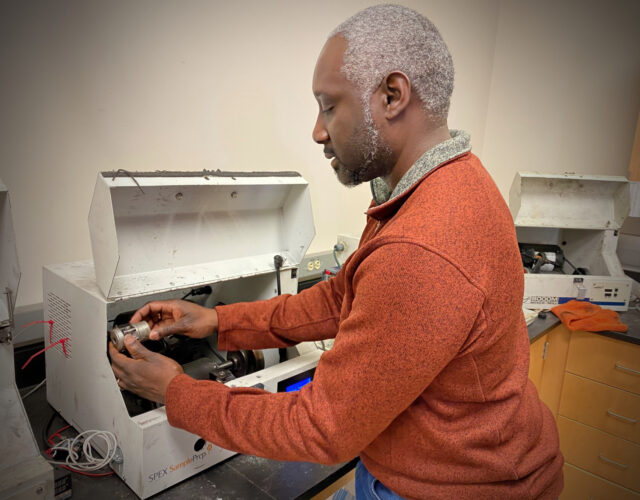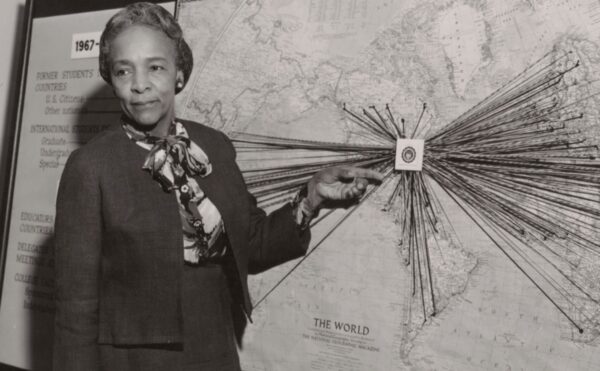What comes to mind when you think of a chemistry lab? Maybe it’s smoke billowing out of glassware, or colorful test tubes, or vats of toxic substances. Chemistry and hazardous solvents just seem to go hand in hand. But chemists like James Mack think there’s a greener way: It’s called mechanochemistry, a kind of chemistry that uses physical force to grind materials instead of solvents. And it’s getting the attention of such huge corporations as Exxon Mobil. Still, some chemists are not ready to give up their traditional techniques. “I thought they were married to the molecules,” says Mack, who is pictured above placing vials into a machine that uses fast-spinning ball bearings to pulverize molecules. “Little did I know they were actually married to the flask.”
Credits
Host: Elisabeth Berry Drago
Reporter, Producer, and Audio Engineer: Jonathan Pfeffer
Senior Producer: Mariel Carr
Producer: Rigoberto Hernandez
Associate Producer: Padmini Raghunath
Image credit: Ann Thompson / WVXU
Transcript
Lisa Berry Drago: Hi, I’m your co-host Lisa Berry Drago. You’re listening to Distillations. Today, we’re gonna talk to you about crushing, smashing, and grinding all for the sake of science. No, it’s not an episode about the Hulk. We’re talking mechanochemistry. What comes to mind when you think of a chemistry lab? Maybe it’s smoke billowing out of glassware or colorful test tubes or vats of toxic substances. Chemistry and hazardous solvents just seem to go hand in hand, and it’s often true.
Chemical reactions can depend upon large quantities of solvent. The chemists use to dissolve reactants, the starting materials in an experiment. These solvents are expensive to store and impractical to recycle, which means they’re often incinerated or disposed of in lakes, rivers, oceans, and then released into the atmosphere.
ABC News: Patty Deggett’s old neighborhood on the city’s south side is still scarred by tap water poisoned in the 1980s by an industrial spill of the chemical solvent trichloroethylene or TCE. Deggett swam in the contaminated water as a child and drank from the tap in her home. In 2014 at age 47, she was diagnosed with a rare form of blood cancer her doctor linked to the chemicals.
Lisa Berry Drago: It’s estimated that 30 to 60 million metric tons of solvents are produced annually mostly by the pharmaceutical and chemical industries. But a growing number of chemists, physicists and mechanical engineers are working together to develop safer, less energy intensive and greener techniques to synthesize chemicals and they’re doing it by not using solvents at all, enter mechanochemistry. Mechanochemists synthesize chemicals through mechanical force, think grinding, pounding, squishing molecules together. The big challenge of mechanochemistry is to understand just how much force is required to cause a chemical transformation to occur.
Tomislav Friscic: This idea that you must always dissolve your substances to do chemistry is somehow ingrained in education, the way we teach chemistry.
Lisa Berry Drago: This is Tomislav Friscic, a leading mechanical chemist and professor at McGill University, whose research is focused on chemical transformations in the solid state. In 2011, Friscic and his team used mechanochemical grinding to safely synthesize Bismuth subsalicylate, Pepto-Bismol’s active ingredient without the use of solvents.
Tomislav Friscic: Existing chemistry is very much based on a paradigm of having to take your components for a chemical reaction for a manufacturing process, and very often dissolving them in solvents in these different liquids. And we wanna change that completely. We really wanna change the way we make things on a chemical basis.
Lisa Berry Drago: Mechanochemistry is a realm of science where the ancient past and the future collide, but it’s nothing new. Nineteenth-century chemist Mathew Carey Lea led the foundation for mechanochemistry right here in Philadelphia. Many techniques stayed back even further. A student of Aristotle’s named Theophrastus conducted experiments of minerals all the way back in the 4th century BC.
If you’ve ever used a mortar and pestle in the kitchen, you’ve basically done mechanochemistry. Modern experiments often take place in ball mills. Think of a mix between a handheld coffee grinder and the bingo machine that randomizes each ball call. Mechanochemists either rotate or shake the container as steel balls of varying sizes grind up the materials inside. Here’s James Mack, a leading mechanochemist and professor of chemistry at the University of Cincinnati with his worm’s eye view of what happens mechanochemically inside these ball mills.
James Mack: Imagine yourself in a room. The goal is you wanna connect with someone in the room, but it was full of liquid, there’s a resistance that you have to fight through to connect with the person. Then a room is starting to shake violently, and then we put a ball bearing on the inside of it and that ball bearing is gonna control how often you interact with the person. And that’s gonna be dependent upon how fast the room shakes and how fast that ball goes. So you can imagine if you are in this room of liquid and you’re trying to meet someone or not meet someone, you also have free will to swim about the room as you see fit.
Lisa Berry Drago: To some, mechanochemistry represents the best of both worlds, more innovation in the spirit of better living through chemistry while doing away with all the environmental risks, kind of seems like a no brainer.
Tomislav Friscic: My experience, skepticism has been overcome with overwhelming optimism that mechanochemistry can not only provide the same thing that classical chemistry can, but maybe achieve that in a faster, cleaner, safer way. I think it actually is likely that solventry processes are going to largely replace traditional methods of chemical manufacturing in the next two decades.
Lisa Berry Drago: Mechanochemistry has become increasingly popular within the scientific community, but a 200-year-old culture of solution-based chemistry poses some challenges in allowing mechanochemists to push the ball forward.
James Mack: We have enough data to demonstrate that mechanochemistry is a very effective methodology to do chemical reactions. And there are still people to this day that go, “No, it doesn’t work.” And trust me, it’s not the data is the reason why they’re saying it’s not working, it’s they don’t want it to work for some other reason in terms of how do they see themselves fitting into this new world?
Lisa Berry Drago: The challenge of finding a new identity in a new culture is one that scientists don’t often discuss. James Mack questions the resistance he’s encountered from his fellow scientists.
James Mack: When you’re doing something differently than other people have done in the past, automatically it sets up, uh, us versus them kind of situation. When I saw this ball bearing, I think I thought, “Huh?” I don’t have to change the way I’m doing chemistry. You’re not asking people to change fundamentally how they use reagents or what reagents to use or anything like that. Basically, you’re telling me instead of putting it into a round flask with liquid, put it in a vial with a ball. I thought they were married to the molecules, little did I know they were actually married to the flask.
Lisa Berry Drago: One persistent problem might be the chemists are trained to be, well, chemists. They’re not necessarily trained to consider all the potential social and environmental impacts of their research. Not to mention, switching from traditional chemistry to mechanochemistry isn’t just about the procedures. It’s about a scientist’s self-image, how they fit into the bigger picture. But some researchers do see the benefits of making a change. Evelina Colacino is a professor of organic and green chemistry at the University of Montpellier in France.
Evelina Colacino: I started as an mechanochemist focusing on, um, medicinal chemistry, so preparation of scaffolds that might have an application in pharmaceutical fields. Little by little, I realized in the daily activity that this way of doing synthesis was harmful for the environment and was generating lot of waste. Mechanochemistry is one of the technologies that allows you to make your process, your synthesis, and what you are creating every day in the lab greener.
James Mack: There are some people who were drawn into the danger of chemistry. Ooh, I like the explosion, I like the meticulous nature of if you don’t do it exactly right, it’s not gonna work out. That becomes a person’s identity. And when they’re not doing that, then it feels like I’m not doing what I came here to do anymore or I’m doing it wrong. Mechanochemistry is so easy, an 11-year-old can do it.
But there are some people in chemistry that goes, “I don’t want people to know an 11-year-old can do it because I want them to look at me and say, ‘You’re a chemist. Ooh, ah, I could never be as worthy as you are.’” Stop using the flask as a way to hold onto something that is not even relevant to what the actual issue is. They don’t want to be left behind. And I will say we don’t always do a good enough job of saying you won’t be left behind and what you’re doing is not gonna go away per se. This is not the cure all for everything. There’s room at the table for everybody.
Evelina Colacino: It’s not just material science chemists or super molecular chemists, organic chemists working independently. Really first time that we have a community working in mechanochemistry altogether, everyone with his own expertise contributing to foster the transition.
Lisa Berry Drago: Mechanochemistry connects several different disciplines, which is a good thing. There are lots of problems in our world that are going to need people with a variety of skill sets to solve them. The question is, how do we get all those individuals to work together? Mechanochemistry isn’t niche science, it bridges inorganic and organic chemistry, material science, pharmaceutical science, and on and on. That’s why the key to success is going to be collaboration.
Robert Carpick: There’s been a lot of tremendous work over many decades where chemists and mechanicians, mechanical engineers, physicists, and others have been all working together as a team to cover all the different facets of this problem, but then connect that to and understand the actual macroscopic outcomes, the synthesis of materials.
Lisa Berry Drago: That’s Robert Carpick, a mechanical engineer and professor of applied mechanics at the University of Pennsylvania. His lab focuses on nanotribology, the study of friction, adhesion, wear, and lubrication at the nano scale.
Robert Carpick: An important, critical ingredient for a sustainable future that tackles environmental challenges, that tackles global warming through reduced energy use has got to involve translating the science of mechanochemistry into industrial practice.
Evelina Colacino: We are in front of a disruptive innovation. Like every innovation, it takes a little bit of time before entering in the common use. I think it’s a multifacet problem, cultural problem, policy problem. Of course, policy can play a very important role so there is a need to introduce a specific policy in order to encourage industry to invest or retool what they already have.
James Mack: Tomislav Friscic
Tomislav Friscic: When we kinda started looking at this maybe 10, 15 years ago, I felt that there were a lot of challenges, that there was a lot of skepticism, along the lines of, you know, this thing is not broken, right? Fix it. And now you have these very interested businesses internationally who are actively developing mechanochemistry.
Evelina Colacino: We really need to have additional data which are beyond the scientific literature is very, very rich already. So academics will do the fundamental studies, but then we need companies to go to the next step.
Robert Carpick: We had some research that was a collaboration with, uh, ExxonMobil Corporation. They’re interested in mechanochemical molecules because they’re used in lubricants. These mechanochemical molecules, when they get squished between surfaces, they can break down and they build up a film on the surface of the steel and that film, it protects the steel from there.
Lisa Berry Drago: When it comes to mechanics, scale is one of the most important factors to consider. The scale of collisions, compressions and forces often correspond to the size of the container and the hardness of the materials. Here’s Daniel Delgande, an undergraduate research assistant in Dr. Carpick’s lab. He’s showing us a device called a mini traction machine. It’s used to measure friction between materials.
Daniel Delgandi: We have a steel ball and a steel disc that we fit into a pot here that can hold lubricant and we can then lower the ball onto the disc and we can vary the load that’s applied, the degree of sliding and rolling in the contact and also the speed at which the parts slide. And through this tailoring of our conditions, we’re also, we’re able to entrap this fluid and have these mechanochemical reactions occur.
James Batteas: We feel like now is a very right time to advance this field by bringing in a lot of the tools that have already been developed in the areas of surface science and applying them to these more complex chemical systems.
Lisa Berry Drago: This is James Batteas, a professor of chemistry at Texas A&M whose lab does groundbreaking research in nano technologies. Like Dr. Carpick, he’s noticed some hesitance around adopting mechanochemistry techniques.
James Batteas: Industry likes predictability. I mean, many chemical processes that are used today have not changed much over the past several decades.
Lisa Berry Drago: Coming up with methods for synthesis that can avoid toxic byproducts is one of the biggest benefits of mechanochemistry, especially when you’re working with noxious materials like say ammonia.
James Batteas: Ammonia synthesis, for example, is one of the most important chemical syntheses in the world. Because without being able to produce ammonia, you can’t produce fertilizer and then you can’t feed half the planet. Now, this process was developed back in the early 1900s, and it relies on catalysts with high temperatures and high pressures of gases, but it was recently show that you can now do this mechanochemically in a ball mill.
You can take iron particles and the collisions of those particles being compressed and shaken up in the reactor can facilitate the ammonia synthesis reaction, but at low temperature and pressures. This really provides an exciting guide to such a critical synthesis showing ways in which it could be done in a much more sustainable way. And I’m not saying that’s gonna happen today or tomorrow, but it really sheds light on the directions that we can take this.
Lisa Berry Drago: Dr. Tomislav Friscic agrees.
Tomislav Friscic: If mechanochemical techniques to conduct chemical reactions, uh, if they’re not adopted, we’re just going to have more of the same old. So we are going to have chemical and manufacturing processes which represent an inherent and large danger for environment. We will be spending a lot of money trying to develop cleaner but maybe not effective processes and then if it does not happen, I don’t think it’s gonna look very good for our future overall.
Lisa Berry Drago: The bigger picture is society needs chemistry and science, but scientists need society too, they’re part of it. It is, and it should be a symbiotic beneficial relationship.
James Mack: I think a lot of the time the scientist doesn’t understand the full needs of society and understand what society doesn’t know to really understand how to fill in the gap appropriately. I think mechanochemistry is gonna flourish in a way of opening up avenues where we can go back in the past, kind of look at some results that didn’t quite make sense then, be able to look at it with a more critical eye and be able to- to analyze it differently and come up with a different conclusion today that we might have come up with 50 or 60 years ago.
Evelina Colacino: The awareness is rising very rapidly in the last year. The mentality has already changed in the scientific community. So I can say that there is a brilliant future for the mechanochemistry.
Lisa Berry Drago: Thanks for listening to this episode of Distillations. Remember, we’re more than a podcast. We’re also a multimedia magazine. You can find our videos, stories, and every single podcast episode at distillations.org and you’ll also find podcast transcripts and show notes. You can follow the Science History Institute on Facebook, Twitter, and Instagram for news and updates about the podcast and everything else going on in our museum, library, and research center. This episode was produced and mixed by Jonathan Pfeffer. The Science History Institute remains committed to revealing the role of science in our world. Please support our efforts at sciencehistory.org/givenow.
For Distillations, I’m Lisa Berry Drago. Thanks for listening.




